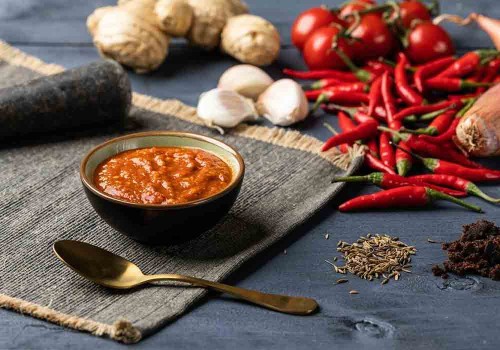
Sambal - a spicy seasoning
Ask an Indonesian where you can buy sambal and you will probably get the answer that it is not for sale anywhere. Why not? Everyone in Asia makes it themselves, because it's just really simple. And when it's fresh it is of course much tastier than the sambal we know from a jar. In addition, the sambal oelek as we know it in Northern Europe is actually a bit 'reinvented'. By the Dutch. The peppers often come from the south of Italy and the Dutch sambal brands have supplied the recipe for the composition of the sambal that you can buy in the store.
A very different taste from the fresh sambal
The difference in taste between sambal from a jar and fresh sambal is caused by the fact that the sambal in the jars contains ingredients to keep it fresh for longer. There is not much wrong with that in itself, but it does of course affect the taste. You can already make the most basic sambal with a maximum of 3 ingredients, namely the peppers and a little salt (to taste). You can optionally add a dash of vinegar.
Sambal is originally Indonesian and Malaysian. The ground Spanish peppers (cabe or lombok for the larger varieties, rawit for the very small, very hot peppers) are therefore the basis for this sauce. Sambal is really intended as an addition to the meal, so not to spread generously over your food. It is a seasoning on the table. In addition, it is also used while preparing various dishes.
European influence
The reason why we often speak of 'chili peppers' is because the Portuguese originally brought this vegetable to their colonies in Asia. This is how the inhabitants of Malacca (Malaysia), Ambon and East Timor came into contact with it. From that moment on, the regular pepper in the dishes was slowly replaced by the spicy variety.
Especially in the Netherlands, sambal became more and more famous after the Second World War. The Dutch who came back from (then) the Dutch East Indies had brought this hot red stuff with them because they had learned to eat it in dishes prepared by their Kokki. It was therefore standard on the table during the eating of the Indonesian rice tables.
Sambal Oelek or do you prefer something else?
Sambal Oelek is probably the most famous variety. The name oelek comes from the pestle with which the peppers are finely ground (pestle and mortar = cobek and ulek).
You could actually say that sambal has a lot of variations. You can add almost anything to the chili and salt base to make your own sambal. This has been done over time, so that we now have a wide choice of flavors. These are, for example, sambals to which fried onions, fermented shrimps (trassi), fruit juice, sugar and all kinds of spices are added.
It no longer has to be the case that these sambals come from Indonesian cuisine.
A list of the different types of sambal:
- Sambal badjak: fried, spicy sambal
- Sambal belacan: the Malaysian variant of sambal trassi
- Sambal djahe: mild sambal with fresh ginger
- Sambal gledek: very spicy sambal
- Sambal katjang: mild sambal, made from peanuts (katjang is peanut)
- Sambal manis: spicy, sweet sambal (manis is sweet)
- Sambal matah: with lemongrass
- Sambal oelek
- Sambal padang: very mild sambal
- Sambal trassi(e): made from shrimp paste (also popular in Suriname)
With our recipes, you will find a few common sambals, so that you can at least make them yourself to combine with your favorite dish.
